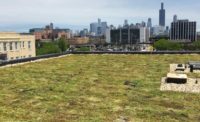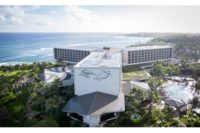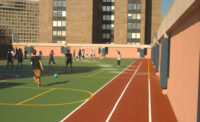
Photo courtesty of Legat Architects, Architect of Record and James Steinkamp, Photographer
Chicago has long been known as the Windy City. But Chicago is earning a new nickname - “Green Roof City.” Much of the credit goes to the Public Building Commission (PBC), which oversees public buildings across the city. Established in 1956, the PBC enhances education, safety and recreation across Chicago and all its diverse neighborhoods by building and renovating schools, libraries, police stations, firehouses, parks and other facilities and amenities.
“The PBC requires LEED Silver Certification for all public projects, and green roofs are a specific requirement,” said Thomas Kikta, AIA, LEED AP, who heads up the Building Envelope Services Team at Legat Architects, Inc. in Chicago. “We’re going for LEED Gold for this project, and our plans for the Mariano Azuela Elementary School featured a green roof.”
New School for an Old Neighborhood
The project to build the new school, which serves 900 students from pre-kindergarten through 8th grade, was completed in July 2010. The 105,000 square-foot, three-story school is a steel frame and masonry construction building that includes science, computer, music and art classrooms, in addition to a library, gymnasium and dining facilities. An office for the adjacent park is co-located in the building.Mariano Azuela Elementary School is in the West Lawn neighborhood of Chicago. Situated a half mile south of Midway Airport, West Lawn is largely a residential community of single-family homes. The neighborhood remains home for the descendants of Eastern European immigrants who have been joined in recent years by Hispanics, primarily from Mexico.
“Most urban school sites don’t have much room for green space,” said Carol Yetken, LEED AP, president of CYLA Design Associates, Inc. “Maximizing exterior green space was emphasized in the site plan for Mariano Azuela Elementary, and a green roof is an element consistent with this emphasis.” Yetken’s firm provided landscape architectural design services for the project.
Choosing a Roof
The green roof for the school is 11,500 square feet in two sections (6,200 and 5,300 square feet). CLYA Design advocated for the LiveRoof Hybrid Green Roof System from LiveRoof, LLC. LiveRoof Standard, a modular, 4.25-inch deep system, was selected for the project.
Photo courtesy of LiveRoof, LLC.
Other modular green roofs are plug-planted systems with sets of trays each with rows of individual plants in one variety. With plugs, it can take two or three years for the plants to grow in and fill in and cover the soil. In contrast, commercial nurseries in LiveRoof’s national network of regional growers start from plant cuttings and fill the system’s modules with an intermingled blend of deciduous, semi-evergreen and evergreen plants. LiveRoof modules go up on the roof fully vegetated with mature plants.
“Parts of the roof are visible from inside the school,” said Matt Wehrle, estimator and project manager, Anderson and Shah Roofing, Inc., the roofing contractor for the project. “So fully vegetated from the start, and full coverage even after the growing season, make for a ‘green’ green roof for the teachers and students to look out on.”
“LiveRoof modules are designed for soil-to-soil contact above, across and in between modules,” said Yetken. “A continuous, interconnected layer of soil is best for the long-term health of the plants.”
Green Roof Benefits
The landscape design for the school includes bioswales and water detention for site drainage and stormwater management. The green roof is part of overall stormwater management for the school. It reduces the volume and velocity of initial runoff during rains. In addition, it helps filter and detoxify stormwater by removing suspended particles and pollutants.The insulation of a green roof can lower indoor sound levels by as much as 40 decibels. Noise mitigation is an important benefit for Mariano Azuela Elementary School.
“The school is situated right under the flight path of nearby Midway Airport,” said Kikta. “With the sound insulation of the green roof, planes taking off and landing at Midway are barely audible in the school. That contributes to a positive environment for teachers and students.”
“The PBC and Chicago Public Schools are out front on green building. It’s part of the educational mission as well as stewardship of the school properties,” said Yetken. “Incorporating sustainability in schools makes green design come alive for kids so they can learn about it and see it not just read about it. Looking out on a green roof is part of this experience.”
Going for Gold
Examples of Green Elements Contributing to LEED Certification Credits:Vegetated Roof: LiveRoof Hybrid Green Roof System
Cool (White) Roof: Flex Thermoplastic (KEE) Roofing Membrane
Lighting:
Fluorescent Direct/Indirect Fixtures: Focal Point, Verve III
Fluorescent Indirect Fixtures: Focal Point, Luna
Light Controls:
Automated Lighting Controls: Leviton
Occupancy and Photo Sensors: Leviton Building Automation System (BAS): Automated Logic
High Efficiency Air Handling Units: Trane
Masonry:
Concrete Masonry Units (CMU): Northfield Block (42 percent recycled content)
Ground Faced CMU: Von Poppelen Brothers (45 percent recycled content)


